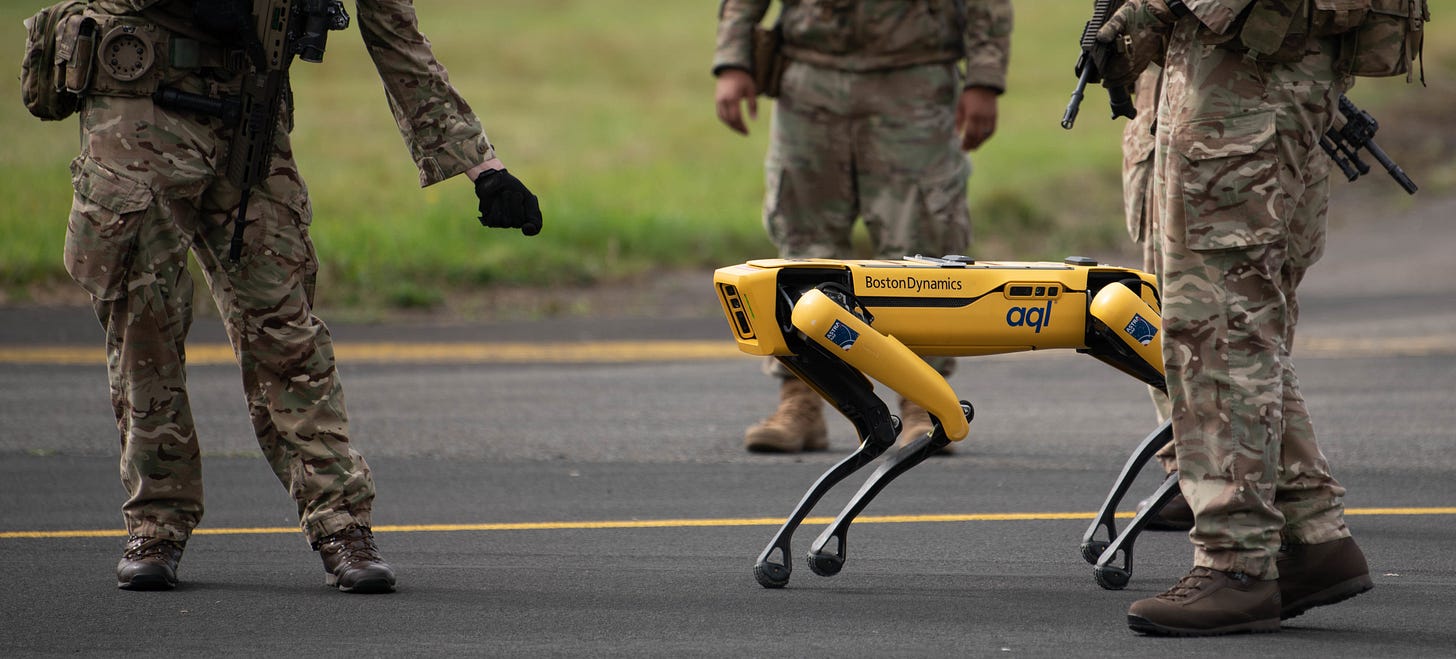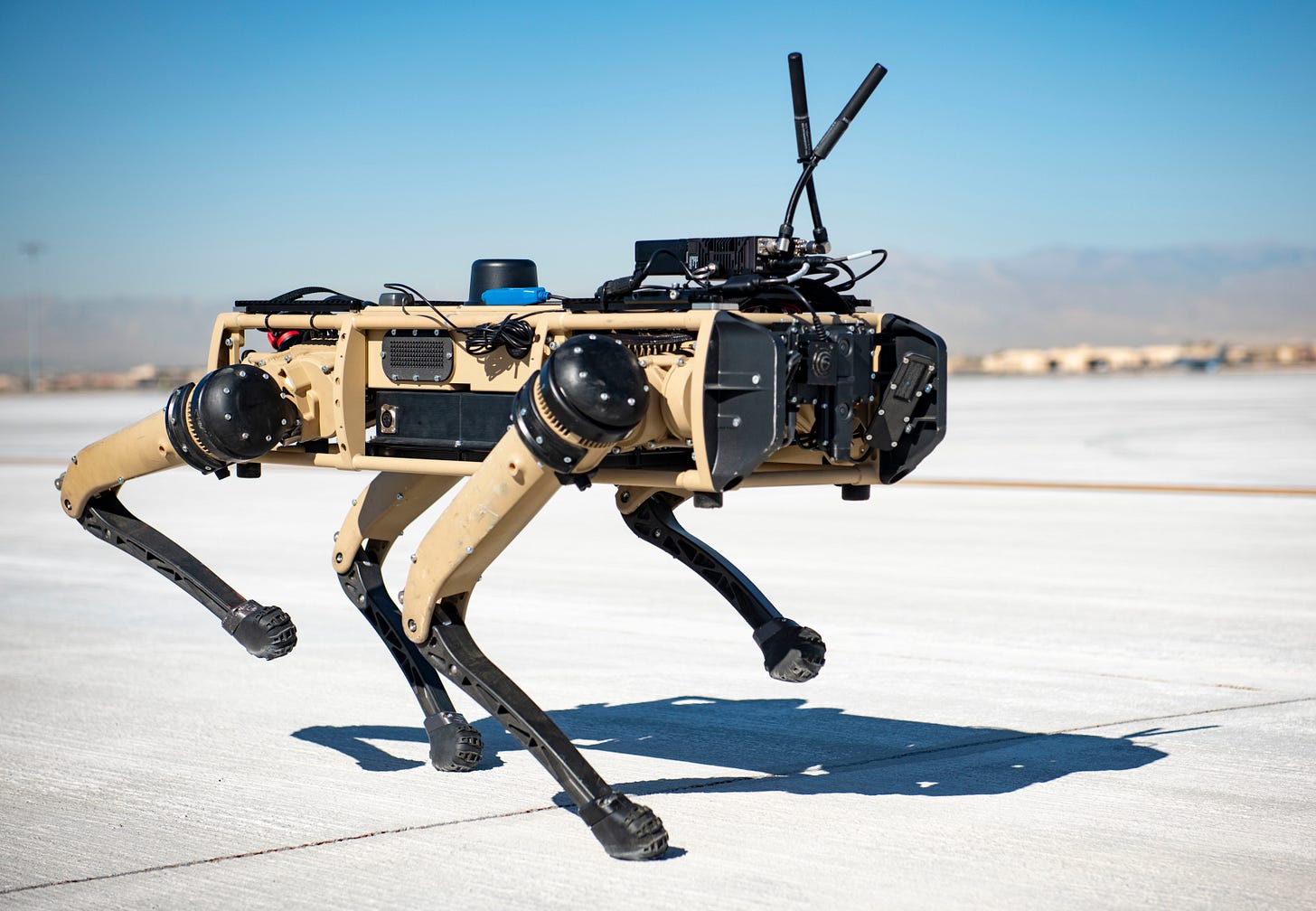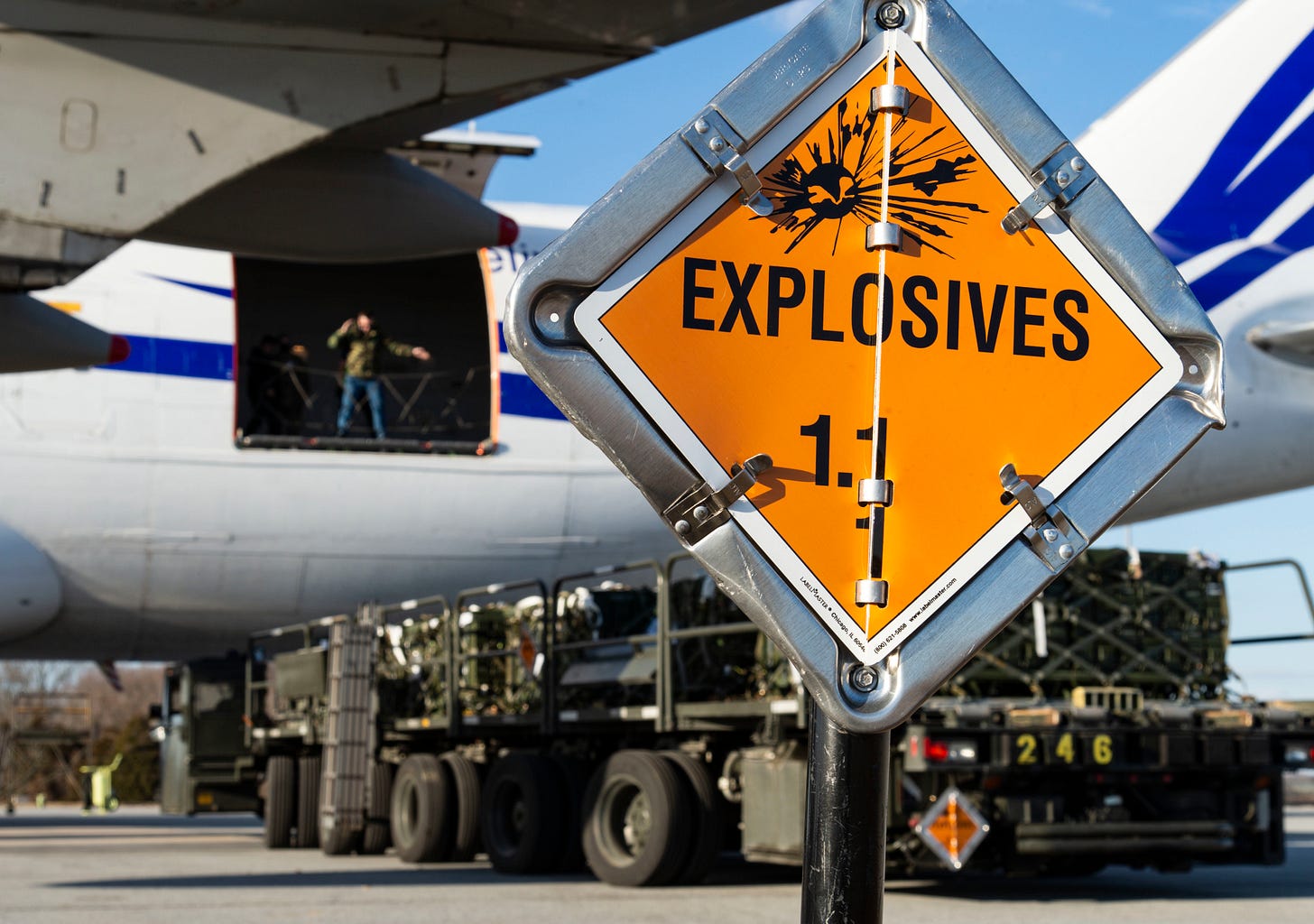February And The Robot Boozehounds of Gimmick Marketing
A subscriber-only update on what I've been up to, and the newsletters I wrote but forgot to share last month.
Edited by Althea May Atherton
Hello readers! It has been quite the month for war, as ominous near-future spilled over to tragedy. I didn’t mean to go all of February without publishing here, but it happened all the same. If you are following Discontents, the collective newsletter I regularly contribute to, then you’ve likely already read the two newsletters I wrote in February.
I value the collective work of Discontents a great deal, and consider it an integral part of what reader support at Wars of Future Past allows me to write. Newsletters risk the worst traits of a la carte media, divorcing beats from context and isolating writers from peers. By working together with the other writers at Discontents, I get valuable peer feedback and can learn from my colleagues. That’s to say nothing of their actual writing and reporting, which manages to cover a range and depth of issues that no single writer can do alone.
This can also lead to some great collaborations. One of my Discontents colleagues is Dave Infante, whose great alcohol industry newsletter Fingers is usually far afield from my regular beat, and a joy to read. For his February 11 newsletter, our beats intersected, and we talked about a combination Boston Dynamics/Sam Adams ad.
From that piece:
“I think seeing Spot in an ad like this is like if the Goodyear Blimp was replaced by a Reaper [drone] or a Black Hawk helicopter for aerial shots of a football stadium,” said Kelsey D. Atherton, a military technology journalist who writes the newsletter Wars of Future Past. The bots’ producer, after all, has its origins in the same military-industrial complex that spawned those high-tech weapons of war. “Boston Dynamics is best known for viral videos of robots doing goofy things, but it started as a military contract,” he said. To understand the high-stakes cultural significance of this low-brow beer ad, its robots’ cutesy star turn must be scrutinized in context. So, let’s!
It was a great conversation and a fun piece, and I’m sorry I didn’t share it with y’all sooner. Still, my first obligation is to you, my paying subscribers, and so in case you are not a Discontents reader, I present my essays from those newsletters, in full.

Scampering Robots, Are You The Destroyer?
This post originally ran at Discontents on February 7, 2022.
On February 1st, Homeland Security announced it was one step closer to deploying robot dogs on the border. Customs and Border Protection, who received the robots, ran them through trials in El Paso, where they explored a building, patrolled a section of desert, and inspected train cars at a rail yard. When it comes to new tools for border violence, it’s never a question about which border will see that technology used first.
I’m Kelsey D. Atherton of Wars of Future Past, and for this week’s Discontents, I’m talking about robot dogs along the border.
Made by Ghost robotics, the Vision series of four-legged machines has already seen adoption by the US Air Force for patrol around bases, and is the result of years of research funded by the military. While superficially similar to the Spot and BigDog robots made by Boston Dynamics, the Vision 60 Q-UGV robots are distinct machines, with a unique balancing system and an acronym-dense name that feels calibrated to be as forgettable as possible. (Q-UGV stands for “Quadruped Uncrewed Ground Vehicle”).
The Vision robot tested by CBP is an expensive camera that can see at night and climb hills, but still needs to ride in the back of a truck after a couple hours in the field. It is another accessory to the violence of the border, a border that in living memory was once so demilitarized it could be crossed on commute in an electric streetcar.
In its announcement of the Vision robot dogs, Homeland Security declared the southwest “a region that blends a harsh landscape, temperature extremes and various other non-environmental threats that can create dangerous obstacles for those who patrol the border” (emphasis added).
From a pure risk assessment position, the Vision robot does absolutely nothing to change the reality that, like all of law enforcement in 2021, Customs and Border Protection overwhelmingly suffered deaths in the line of duty from COVID, not violence.
The southern border includes deserts inhospitable to people trying to cross them, made more so by the actions of Customs and Border Protection. Surveillance towers, often placed near the border in the name of better situational awareness, have been shown to have a measurable effect on reducing the survival chances for people trying to cross the Sonoran desert into Arizona. People will move through harsher routes to avoid detection, and in so doing, distance themselves from water, shelter, and the possibility of compassionate rescue.
While the Trump administration was an exceptionally blunt advocate of harsh policies on the border, the conscious policy decision to force crossings into harsh desert can be traced back to decisions by the Clinton administration in 1994, and an expansion of surveillance technologies on the border continues under the Biden administration.
The desert is harsh, but border crossings do not have to be, and Border Patrol has a long history of explicitly making those crossings harsher, including destroying the water containers placed in by humanitarian groups for the survival of anyone making the crossing.
In its announcement of a dog-shaped robot for use on the border, a CBP agent listed the dangers faced by CBP officers, with lines dusted off the first decade of the War on Terror. The dangers listed include smuggled humans, drugs, weapons, and even weapons of mass destruction. This line is the only mention in the announcement of the robot potentially being used to find people.
The robot is not being pitched as a desert rescue tool, where its familiar form could offer a gentle welcome to people suffering and in need of assistance. Instead, the robot will be used to protect the humans of Customs and Border Protection, and in that role receives more compassion than anyone crossing a border.
Ghost describes their Vision-60 version of the robot as carrying up to 20 pounds of cameras and other sensors, operating for about 3 hours, and traveling a total distance of slightly less than 8 miles, all at a top speed of less than 7 mph. That’s a small, limited frame on which to rest expectations of life-saving and officer protection, when at best it might be able to in some circumstances see people hiding first.
In civilian and military contexts alike, people extend the same sympathies they have for companion animals to useful robots. It’s no surprise that Homeland Security describes a robot tested for service with familiar language, but it’s still jarring to read.
Throughout the release from DHS, the Vision robot is referred it as a “robot dog,” “quadruped mechanical reinforcement,” “Man’s best friend with a very futuristic twist,” a “four-legged ground drone solution,” a “battery-powered pooch,” and a “robot “Fido”.” This robot doesn’t just contribute towards mission success, it lends a “a helping hand (or “paw”),” and it wasn’t designed and assembled by humans to specifications but was instead “bred for exactly the type of work that CBP needs done.”
The four-legged robot is not a living being, though that won’t stop people from responding to it as one. Homeland Security already branding an unfeeling machine with the gentle language used for beloved pets feels not far off from prioritizing the safety of the machine over the safety of the people it is sent to detain.
If this robot dog is upsetting, that’s because it makes visible the institutions it serves. Left unchallenged, in time robot dogs will become a routine tool, rather than an extraordinary one. What will remain is the institution of violence, equipped with an ever-growing box of toys.

War machinery and beatdown journalism
This post originally ran at Discontents on February 28, 2022.
The technology of war is beat journalism until it is everything journalism. In October, satellite footage first revealed the Russian military massing machinery of war near Ukraine. Last week, months of preparation were bent towards tragedy, with Russia invading its more democratic neighbor to the south.
The stuff of war is material: armored vehicles, stockpiles of ammunition, trucks for resupply of everything from fuel to bullets to blood. It unfolded clearly on satellite imagery, spotted by government spies and public observers alike. In my corner of journalism, covering this buildup meant putting together lists of tanks and artillery weapons, existing machines that would take lives in the days or weeks ahead.
The Smerch, one of a number of artillery platforms brought into war on Ukraine, fires salvos of rockets, with area hit measured in the dozens of hectares. Here’s how I described its effect for Popular Science, days before the invasion:
Inside each rocket is either one large warhead, five anti-tank warheads with a guidance sensor, or 72 submunitions. These submunitions are themselves fragmentation explosives, turning one rocket into 72 smaller bombs that explode into nearly 400 pieces, a fractal of destruction.
The Smerch, like all cluster munitions, is deadly in action and for years or decades to come, with every unexploded bomblet a future tragedy in waiting.
There is an abstraction to writing about these weapons in the context of a war not yet come to pass. I wrote about the Smerch the same way, despite its well-documented use by Russian, Syrian, and Azerbaijani forces in the last decade. It’s been a weapon of present tense since it was created, and of tense presents.
Discontents regular Jack Crosbie, of Discourse Blog and Rolling Stone, has been reporting from Kharkiv. Here is an excerpt from his latest dispatch, on what it is like to live and report in a hotel in a city under attack:
We spent most of the day on Sunday in the lobby, devising a new threat assessment method based on the duration and volume of shelling outside. Silence was relaxing — boots off, naps on the couch, perhaps a trip back up to the rooms on upper floors for a shower or change of clothes. Occasional, faint shelling meant you put your shoes back on. Louder shelling meant body armor on and debate over whether or not to go to the car park, hoping that by the time you had finished discussing the shelling would stop. Anything more than that meant a trip back to the patio furniture and insulation pads downstairs.
The technology of war is abstract, until it’s the reason sleeping in a car park becomes a regular part of your daily routine. These machines are, in every turn, something terrible that happens to people.
That’s what war is, fundamentally. It’s tragedy where the instruments are 19-year-old conscripts and biologists returning to the front as military reservists. This violence is, in part, mediated by expensive machines and professional soldiering classes, but the commissioning of military violence means at all times authoring the potential that civilians will end up dead in the act. This is true for all wars, from Russia’s ongoing invasion of Ukraine to the US drone strikes on Somalia to the Saudi campaign of bombardment in Yemen.
The war on Ukraine has revealed, at least, an ability to call out some imperial violence as such, even within the bounds of formally neutral outlets. Yet for the profession of war-describers to live up to the obligation of our grim profession, it cannot be limited to describing the violence of this war alone as beyond the bounds of civilization.
The machinery of war matters. But it matters primarily because of what it means for the humans holding the weapons, and especially for the humans on the receiving end. It is easy to tell a story of what a weapon means in the abstract. It is much harder, and much more important, to honestly describe what life is like for people surviving on the receiving end of artillery for hours, for days, for months.

Thank you all for reading. I truly appreciate knowing that I have a dedicated audience for writing like this. Likewise, I encourage everyone to read Discontents, where recent entries also include Luke O’Neil on surviving the economy and Spencer Ackerman on how torture remains illegal if it’s not done by the CIA.
This month, I hope to have at least one more newsletter for you all. In addition, you can find my coverage of Russia’s war on Ukraine primarily at Popular Science and at the Center for Public Integrity. There, I have covered Russian and Ukrainian weapons, why geography made Chernobyl a staging ground for the siege of Kyiv, and how the existence of nuclear arsenals shapes and constrains the war.
In addition, this month I took over writing the Critical State newsletter from The World and Inkstick Media. I loved reading the newsletter in its original form by my fellow Fellow Travelers Blog cofounder Sam Ratner, and I hope to bring the same sensitives to world news writing in the weeks ahead.



